Abstract
Irrigation management in areas affected by climate change requires an accurate determination of transpiration losses in crops, such as grapevines. The existing literature has primarily focused on estimating transpiration losses based on two critical microclimate factors: vapor pressure deficit (VPD) and solar radiation intensity (Rs). However, most studies have been conducted under abundant soil water availability conditions, whereas research under limited water availability remains scarce. Thus, this study aims to develop models capable of accurately determining transpiration losses of grapevines under both full irrigation and limited soil water conditions. Sap flow sensors using the heat ratio method were employed to measure transpirational losses. These measurements were compared with the results from the models afterward. The results suggest that VPD was the dominant factor affecting canopy conductance, which decreased exponentially as VPD increased. Furthermore, a piecewise linear regression analysis revealed a threshold value for Rs during both study years. This finding suggests that Rs impacts transpiration losses in two distinct ways, highlighting the necessity to develop two separate models for determining transpiration losses each study year. The estimation capability of the models was verified using the k-fold cross-validation method, suggesting that reliable predictions can be made under both well-watered and rainfed conditions.
1. Introduction
Agriculture in the Mediterranean basin is increasingly exposed to prolonged drought periods as a result of climate change, experienced by the increase in average temperature and the reduction in precipitation events. Understanding plant transpiration dynamics is crucial for improving water use efficiency in agricultural systems, particularly in regions suffering from water scarcity. At the leaf level, stomata regulate the exchange of water and carbon between the plant and the atmosphere, significantly influencing plant water use efficiency and ultimately productivity [1,2]. Canopy conductance (gc) is a key determinant of transpiration that reflects the integrated stomatal response to different environmental conditions [1,3]. Stomatal behavior is influenced by environmental drivers across plant species, particularly vapor pressure deficit (VPD) and solar radiation (Rs), which regulate water loss and carbon assimilation [4,5,6]. The relationship between gc, VPD, and Rs has been widely studied in natural ecosystems [7,8] and horticultural plants such as grapevines [5,9,10]. In general, increases in Rs tend to enhance photosynthetic activity and promote stomatal opening, thereby increasing gc, while rising VPD values define a more complex pattern by either stimulating [11] or restricting [12] stomatal conductance depending on the degree of atmospheric demand and soil water availability [13]. However, the effects of VPD and Rs on gc of table grapevine varieties have been mainly conducted under well-irrigated conditions. Evaluating stomatal responses under contrasting soil moisture regimes remains critical for optimizing irrigation strategies and improving the predictability of grapevine water use. Grapevines (Vitis vinifera L.), known for their anisohydric or near-anisohydric stomatal behavior [14], dynamically regulate gc in response to environmental and soil moisture conditions [15,16,17,18,19].
These ecophysiological responses can be described using mathematical models with empirical and mechanistic approaches commonly applied [9,10,20,21]. For example, Lu et al. [10] developed nonlinear empirical models to predict gc in well-watered ‘Sultana’ grapevines based on Rs and VPD. However, their models were not validated under water stress conditions. On the other hand, Egipto et al. [9] developed a biophysical model regarding the ‘Tempranillo’ variety that scales stomatal conductance to water vapor by leaf area index (LAI) and incorporates net solar radiation and VPD to estimate gc. Additionally, Bai et al. [5] using diurnally segmented linear and logarithmic functions, modeled the responses of gc in furrow-irrigated ‘Thomson seedless’ grapevines grown under oasis conditions. The previous examples highlight the diversity of modeling approaches. Model selection is therefore critical in ensuring the robustness of transpiration predictions [22]. The Akaike Information Criterion (AIC) [23,24] is frequently used to compare models with different structural assumptions, while k-fold cross-validation [25] offers an additional measure of model generalizability and predictive accuracy.
The aim of the present study is (i) to evaluate the responses of gc to VPD and Rs under two distinct soil moisture conditions of a commercial vineyard: well-watered and rainfed conditions, (ii) to develop appropriate models to describe these dynamics based on the observed responses accurately, and (iii) to use model predictions of gc to estimate canopy transpiration (Ec) and compare these estimates with transpiration rates measured via sap flow-derived data in order to develop a robust methodology that can be used as an effective tool for optimizing irrigation strategies.
2. Materials and Methods
2.1. Description of the Experimental Site and Monitoring of Environmental Parameters, LAI, and Soil Moisture
This experiment was conducted in a commercial vineyard located in Northern Peloponnese, Greece, cultivated with seven-year-old grapevines (Vitis vinifera L. cv. Thomson Seedless) grafted on 110 R rootstock. The vines were grown on deep, heavy-textured clayey soil, with a volumetric water content at field capacity of 44.2% and at permanent wilting point of 32%. The vineyard was planted at a spacing of 2.5 m within the rows and 3.5 m between, following a northwest–southeast orientation.
This experiment was conducted during two consecutive years, 2023 and 2024, under contrasting soil moisture conditions. In 2023, plants did not receive any irrigation, and no rainfall was recorded during this experimental period, resulting in dry soil conditions. On the other hand, during 2024, vines were regularly drip-irrigated at a discharge rate of 2 L per hour to ensure well-watered conditions.
Moreover, throughout both study years, the grower followed the same agricultural practices regarding fertilization and plant protection. During the experimental periods, plants were fully developed as indicated by regular measurements of leaf area index (LAI) conducted using an LAI-2000 Plant Canopy Analyzer (LI-COR Biosciences, Lincoln, NE, USA) following the methodology described by Patakas and Noitsakis [26].
Microclimatic parameters, including solar radiation intensity (Wh/m2), wind speed at a height of 2 m (km/h), rainfall (mm), relative humidity (%), and air temperature (°C), were continuously recorded on an hourly basis by a weather station that was permanently installed in the field. These measurements were used to calculate vapor pressure deficit (VPD) according to Allen et al. [27].
Soil volumetric water content was continuously monitored using EnviroSCAN capacitance sensors (EnviroSCAN, Sentek Sensor Technologies, Stepney, Australia) calibrated according to the manufacturer’s guidelines. These sensors were properly installed from 10 cm below the soil surface to a depth of 100 cm to record soil moisture dynamics at 10 cm intervals within the active root zone of the plants [28].
2.2. Measurements of Sap Flow
Three representative plants with similar trunk height and circumference, located at a central point of the plot, were selected to conduct measurements of sap flow. On each vine, one SFM1 sap flow sensor (ICT International, Armidale, NSW, Australia) using the heat ratio method [29] was installed on the northeastern side of the trunk, approximately 45 cm above the soil surface. The sap flow sensors were installed on the plants before the bud burst, when the plants were completely leafless, ensuring that the measured sap flow velocity during this period was effectively zero. This zero-flow confirmation served as a reference for sensor offset correction. Sap flow measurements were conducted over 31 days each experimental year, at the same phenological stage, corresponding to the ‘berry touch complete’ stage (BBCH code 79, [30]).
2.3. Measurement of Canopy Conductance and Canopy Transpiration
Hourly values of canopy transpiration (Ec) were calculated as follows [5]:
where Ec is total plant transpiration (mm/h), SF is sap flow measurements (kg/h), AL is plant leaf area (m2), and LAI is the leaf area index.
Canopy conductance (gc) was calculated on an hourly basis, according to the following equation [31]:
where gc is canopy conductance (mm/s), λ(Τ) is the latent heat of vaporization of water (J/kg), Ec is canopy transpiration as mentioned previously, γ(Τ) is the psychrometric constant (kPa/°C), ρ(Τ) is the density of water in the liquid phase (kg/m3), Cp is the specific heat of air (MJ/kg °C), and VPD is the vapor pressure deficit (kPa).
2.4. Modelling of Canopy Conductance and Canopy Transpiration
During the experimental period in 2023, plants did not receive any irrigation (rainfed), while in 2024, they were regularly irrigated to ensure well-watered conditions. Under these completely different soil moisture conditions, gc values were estimated using Equation (2), which have been reported to accurately represent the strong correlation between gc and key environmental parameters like VPD and solar radiation (Rs) [6,7,8]. Additionally, predicted values of gc were estimated using the model developed and validated by Lu et al. [10] for Thomson seedless grapevines of similar age to those used in the present experiment. This modeling approach, while relatively simple, incorporates all critical microclimatic parameters. On the one hand, VPD, a compound variable derived from temperature and relative humidity, captures the combined effects of these two factors. On the other hand, Rs was included directly in the modeling process as an independent variable. Furthermore, as described earlier (Section 2.1) soil moisture remained nearly constant throughout each experimental year, eliminating confounding effects. Therefore, a separate sensitivity analysis was considered unnecessary, as all relevant physiological drivers were either included in the modeling process or effectively controlled. The above-mentioned model is mathematically represented by the following equation:
where a, b, and c are parameters to be fitted.
The predicted gc from this model was subsequently used to estimate Ec by solving Equation (2) for Ec. The estimated values were then compared with the measured Ec obtained from sap flow measurements (Equation (1)).
To identify potential outliers, residual diagnostics were conducted to assess the distribution of residuals relative to fitted values and observation indices, enabling also the detection of non-random patterns, heteroscedasticity, and influential observations. Residuals were plotted against fitted values to determine whether they were randomly distributed around zero, indicating the absence of systematic bias. Additionally, residuals were examined against the observation index to identify potential temporal or sequential patterns that could signal structural issues within the dataset. Outliers and influential points were flagged based on extreme deviations in residual values, particularly those exceeding two standard deviations from the mean residual. Further evaluation of these points was carried out using Cook’s Distance and leverage diagnostics, which, although traditionally applied in linear regression, have been adapted for use in nonlinear regression models to assess their influence on model stability [32,33].
The performance of the fitted models was assessed using the residual standard error (RSE), which quantifies the typical deviation of observed values from predicted values, providing a direct measure of model accuracy [32]. RSE was also preferable to other metrics, particularly in the case of nonlinear models, where traditional goodness-of-fit measures such as the correlation coefficient may be less appropriate [34,35].
2.5. Breaking Point Threshold for Canopy Transpiration Versus Solar Radiation
The ‘breaking-point’ threshold was identified through piecewise linear regression analysis, performed using the ‘segmented’ package [36,37] in R [38]. Visualizations to support this analysis were created with the ‘ggplot2’ package [39]. During the two experimental years (2023 and 2024) the identified breaking point thresholds served as critical reference points. These thresholds marked the transition from one Rs condition to another during daytime hours, indicating the need to develop two distinct models for the accurate estimation of gc before and after each threshold, which were validated.
2.6. Cross-Validation of Models
To assess the predictive performance and generalizability of the models, the k-fold cross-validation technique was implemented [25]. A value of k = 10 was selected, as it is considered to provide reliable results leading to robust models [40]. Thus, for each model, the dataset was partitioned in k = 10 equally sizes subsets (folds): each model was trained on nine (9) folds and then tested on the remaining one (1) fold. This process was repeated across all ten folds and the root mean square error (RMSE) and coefficient of determination (R2) were calculated for each iteration. The final performance metrics were the average RMSE, the normalized RMSE (RMSEnorm, %), the ratio of average RMSE to mean value of gc, and average R2 across all folds.
In cases where a comparison between two models for the same dataset was required, the Akaike Information Criterion (AIC) was employed as a model selection metric alongside k-fold cross-validation [23,41].
3. Results and Discussion
3.1. Hydrodynamic and Environmental Parameters
The evaporative demand, expressed as hourly VPD values, exhibited no statistically significant differences between the two study years. The mean hourly VPD was 2.43 ± 1.3 kPa in 2023 and 2.29 ± 1.24 kPa in 2024 (Figure 1). In addition, no precipitation was recorded by the meteorological stations in both years, while marked differences in soil moisture content at the root zone were evident. In particular, soil moisture content in 2023 remained at minimum values (approximately 32%) due to the absence of irrigation and rainfall. In contrast, in 2024, the soil moisture level was consistently high as a result of regular irrigation (Figure 2). Furthermore, the leaf area index (LAI) values remained practically unchanged throughout the 31-day experimental period in each year, which is consistent with previous studies reporting minimal variation in LAI even on more extended experimental periods [5].

Figure 1.
Boxplot comparison of air VPD (kPa) between the two study years. The notation ‘ns’ indicates no statistically significant differences between years at α = 0.05.
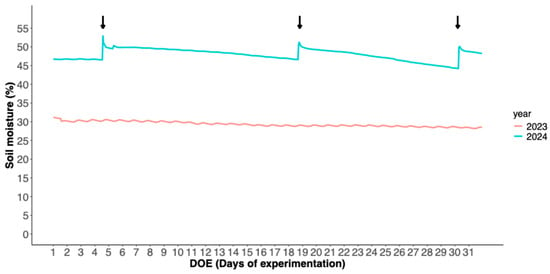
Figure 2.
Hourly changes in average soil moisture (%) from 10 cm to 70 cm during the experimental period of the two study years. Black vertical arrows show the irrigation during 2024.
On the other hand, statistically significant differences (α = 0.05) were observed in sap flow measurements (Figure 3), which could be attributed to the differences in soil moisture availability.
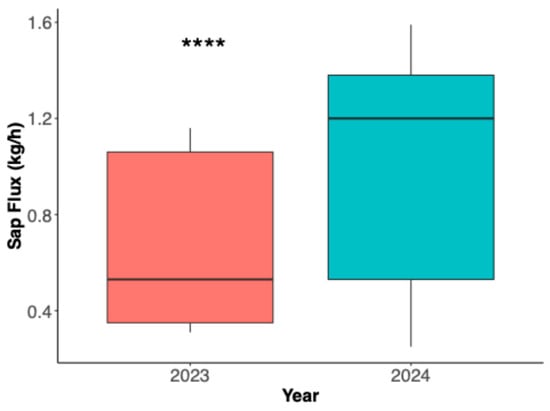
Figure 3.
Comparison of sap flux between the two study years. Asterisks (****) indicate statistically significant differences (p < 0.0001).
The diurnal variations in sap flow exhibited a typical pattern similar to that of VPD and Rs throughout the experimental periods of 2023 (Figure 4) and 2024 (Figure 5). Specifically, sap flow reached minimum values at night, increasing immediately after dawn and during early morning, reaching maximum values around solar noon and then gradually declining in late afternoon until dusk. This similarity in diurnal trends suggests a strong relationship between sap flow, VPD, and Rs, which is consistent with the results reported in previous research [42]. Indeed, in our results, hourly values of sap flow exhibited a relatively strong correlation with hourly values of VPD and Rs in 2023 (0.72 and 0.94, respectively) and 2024 (0.69 and 0.81, respectively) (Figure 6).
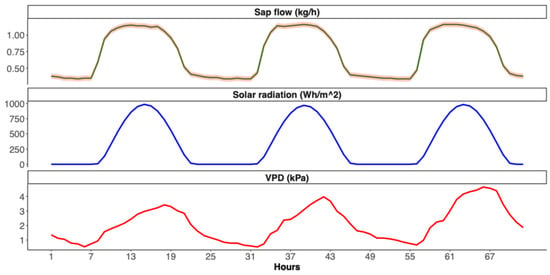
Figure 4.
Hourly variation of sap flow (with standard error), VPD, and solar radiation over a randomly selected 72-h period in 2023 (from DOE 1 to DOE 3).
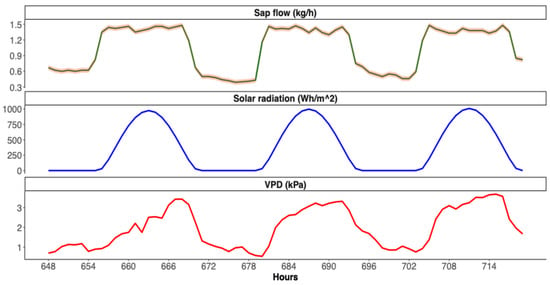
Figure 5.
Hourly variation of sap flow (solid line) with confidence interval (shaded area), VPD, and solar radiation over a randomly selected 72-h period in 2024. Note: The hours displayed on the x-axis begin from the first hour of the initial day of experimentation (DOE 1), and here, they correspond to the 28th and 30th DOE.
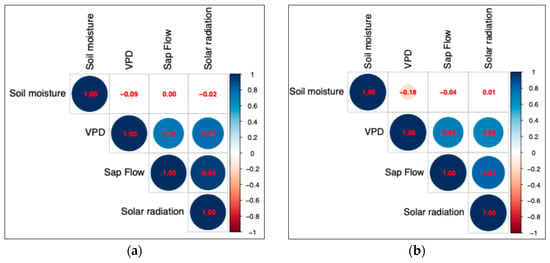
Figure 6.
Correlation between hourly values of sap flow, microclimatic parameters, and soil moisture content in 2023 (a) and 2024 (b).
Furthermore, the correlation analysis indicates a strong relationship between hourly values of VPD and Rs, particularly on cloudless days, which are typically prevalent during the experimental period. According to Figure 6, the correlation between these variables was 0.77 in 2023 and 0.69 in 2024. However, while hourly values of Rs follow a relatively stable daily pattern, changes in hourly values of VPD on a diurnal basis exhibited significant variability during the studied period (Figure 5), which has also been well documented in the literature. For instance, Lu et al. [10] reported pronounced day-to-day fluctuations in VPD, particularly during the afternoon. Similarly, Bai et al. [5] observed substantial VPD variation between 11:00 and 17:00, with values ranging from ca 2 kPa to ca 4 kPa. Additionally, Kokkotos et al. [43] reported nocturnal fluctuations in VPD, ranging from 0.15 kPa to ca 2.5 kPa. Similar trends were observed in the present study with VPD ranging from 0.15 kPa to 4.13 kPa in 2023 and from 1.63 kPa to 4.64 kPa in 2024, particularly around solar noon.
3.2. Modelling of gc
3.2.1. Case 1: Non-Irrigated Grapevines (2023)
Throughout the 2023 experimental period, the relationship between gc and VPD values exhibited a nonlinear pattern irrespective of Rs values (Figure 7a,b). However, also taking into consideration the changes in Rs, the relationship between VPD and gc can be obviously divided into three subgroups: (i) the first subgroup includes the measurements recorded during nighttime that correspond to Rs values that are equal to or approximately zero (Rs < 1 Wh/m2), (ii) an intermediate subgroup corresponds to a gradual increase in the values of solar radiation during the morning, and (iii) the third subgroup corresponds to maximum or near-maximum Rs values (>750 Wh/m2) (Figure 7a).
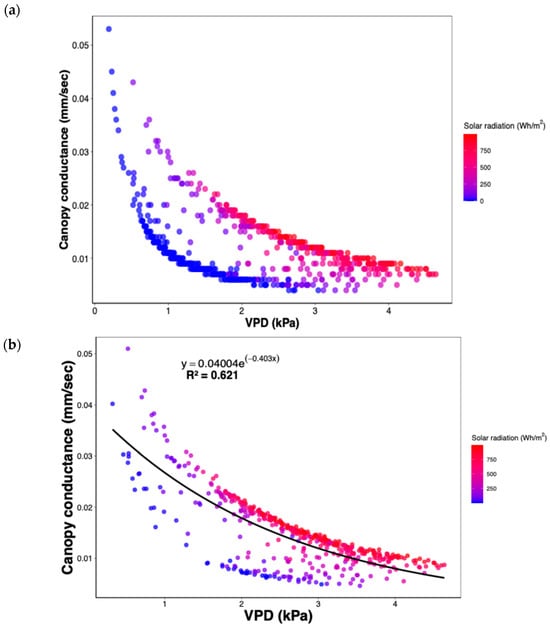
Figure 7.
Relationship between gc and VPD during 2023 for the entire dataset (a) and for conditions where solar radiation (Rs) > 1 Wh/m2 (b). The corresponding color gradient of the points represents variation in the intensity of solar radiation.
The pronounced influence of Rs on the relationship between VPD and gc highlights the inherent difficulty of constructing a single model capable of accurately estimating gc across varying solar radiation regimes. To address this challenge, previous studies have commonly restricted their analyses to midday measurements, thereby eliminating the confounding effects of low Rs values on stomatal behavior [9,44,45,46]. Nevertheless, the inclusion of a broader range of data, including periods with lower values of Rs, is of particular interest, as it enables a more comprehensive exploration of the dynamic covariation between gc and microclimatic factors throughout the daytime period [5]. Considering these complexities, an alternative way may be the development of distinct models developed for specific ranges of Rs with enhanced predictive accuracy. Within this frame, the first step focused on determining the critical ‘breaking point(s)’ of Rs values, which underscores the necessity of developing a different model. A comparable approach to separating data based on Rs has been employed in previous research on grapevines, albeit using a fundamentally different approach. For instance, Lu et al. [10] visually identified a clustering of data points above and below a value of 200 Wh/m2. In another study, Bai et al. [5], examining the hysteresis in the relationship between gc, VPD, and Rs, identified three distinct subgroups: from 07:00 am to 11:00 am, from 11:00 am to 17:00 pm, and from 17:00 pm to 21:00 pm, each corresponding to different patterns of gc response over the course of the day. In the present analysis, it was determined that, after excluding night-time values, the critical Rs threshold indicating the need for model differentiation was 270 Wh/m2 in 2023 (Figure A1a). Therefore, the previous value serves as a threshold distinguishing two different conditions: (i) below the breaking point (bp), where stomatal activity increases rapidly with Rs following a steeper slope, indicating the significant influence of Rs on the stomatal opening, and (ii) above the breaking point (bp) where the increase in stomatal activity slows, suggesting a potential regulatory mechanism (stomatal control) to limit further water loss.
Model I—2023 (Below the Threshold Value of Rs)
Changes in canopy conductance in relation to VPD for Rs values < 270 Wh/m2 follow an exponential decay (gc = 0.039e(−0.633VPD)) (Figure 8). The adjusted R2 (0.703) indicates that VPD explains a significant proportion of the variability of gc, and this value reflects a considerable increase in explanatory power achieved after segmenting the dataset based on Rs thresholds compared to the ‘non-segmented’ data set (Figure 7b). As explained above, Rs is the other independent variable that significantly affects transpirational fluxes.

Figure 8.
Relationship between canopy conductance (gc) and VPD for observations below the threshold of solar radiation (Rs) during 2023. The data points are color-coded according to solar radiation, as indicated in the legend on the right. The red curve represents the fitted exponential model, and the grey shading denotes the 95% confidence interval.
Unlike Lu et al. [10] who found that a linear model better explains the variability beneath the threshold value of Rs, in our study, the exponential model described in Equation (3) was formulated as follows:
The statistical significance of all parameters (Table 1) confirms their strong influence on gc. The residual standard error of 0.004004 suggests a well-fitted model with minimal deviation between observed and predicted values. Through this modeling, the significant negative effect of VPD on gc is confirmed (b = −1.000), aligning with the exponential decay function visualized in the first scatterplot, where gc rapidly declines as VPD increases. This behavior reflects a well-known stomatal regulation mechanism, where plants reduce conductance to prevent excessive water loss under high evaporative demand, especially under a scarcity of soil moisture deficiency [47]. On the other hand, the estimated coefficient for Rs (c = 4.088 × 10−5), although small, is statistically significant, indicating that Rs contributes to gc but to a much lesser extent than VPD. Even though Rs is a primary driver of stomatal opening for carbon assimilation, in this particular case, its influence on gc appears to be minor compared to VPD. This observation suggests that water loss regulation is prioritized over photosynthetic demand under increasing atmospheric dryness [48].

Table 1.
Fitted values of Model I (below the threshold value of Rs in 2023).
The next step is the regression diagnostics analysis to examine the model’s suitability. Figure 9a shows the distribution of the residuals versus the fitted values. Although residuals spread relatively symmetrically around the horizontal axis, there is a minor pattern suggesting potential heteroscedasticity, possibly due to the specific conditions regarding the significant rise in Rs from very low to moderate levels. On the other hand, it is important to consider the absolute value of the residuals. In this study, the distribution range is between −0.005 and +0.005, whereas other studies reported a range of ca. −2 to ca. +2 [10,49].
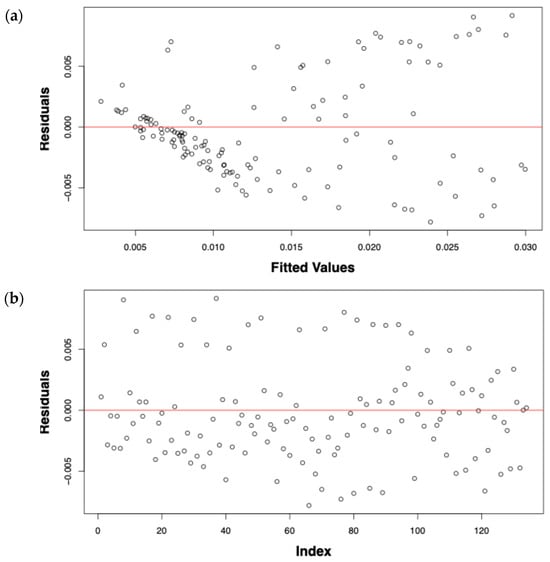
Figure 9.
Residuals diagnostic plots for Model I. Residuals versus fitted values (a) and versus index (b).
Moreover, the low residual standard error (0.004004) confirms the model’s predictive accuracy. Also, in Figure 9b (‘Residuals versus Index’), the model’s reliability is further supported, as no systematic pattern or temporal autocorrelation occurred, confirming an independent distribution of the residuals over time.
Despite the presence of minor heteroscedasticity in the ‘Residuals vs. Fitted Values’ plot, the model remains adequate and sufficiently precise, as evidenced by the low residual standard error (0.004004), while the ‘Residuals vs. Index’ plot further supports the model’s reliability, as it does not indicate systematic patterns or temporal autocorrelation, confirming that the residuals are independently distributed over time.
The predictive performance and generalizability of the proposed model were assessed by the k-fold cross-validation (k = 10) approach. The model achieved an average root mean square error (RMSE) of 0.00112, indicating a very low deviation between observed and predicted values, further confirming the precision of the model. Additionally, the average coefficient of determination (R2) was 0.962, suggesting that the model explains 96.2% of the variance in the dataset, demonstrating a strong predictive capability. The low RMSE suggests that the model exhibits minimal error, making it highly reliable for estimating transpiration fluxes under varying environmental conditions. Meanwhile, the high R2 value indicates that the selected predictors effectively capture the underlying physiological relationships governing sap flow and canopy conductance. These findings align with the corresponding results of other studies where Rs and VPD were considered the principal estimators of canopy conductance and transpirational fluxes [6,8,9] (Figure 10).
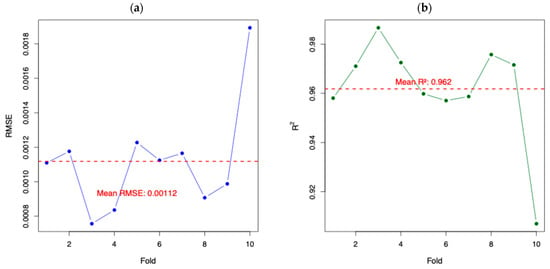
Figure 10.
Variation of RMSE (a) and R2 (b) per fold regarding the cross-validation of Model I.
Model II—2023 (Above the Threshold Value of Rs)
Similarly to the previous case, the relationship between gc and VPD follows an exponential decay function (Figure 11). The results suggest that the most suitable model for describing gc as a function of VPD and Rs is expressed as follows:
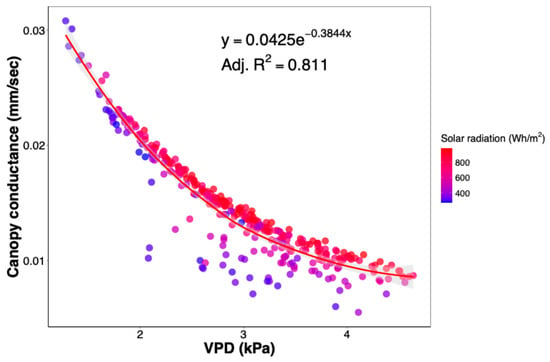
Figure 11.
Relationship between canopy conductance (gc) and VPD above the threshold of solar radiation (Rs) during 2023. As previously described, data indicators are color-coded according to the intensity of Rs as indicated in the legend on the right. The grey-shaded area represents the confidence interval at α = 0.05.
The residual standard error of this model (0.0008405) indicates a strong fit and relatively high predictive accuracy of the model. Furthermore, the estimated parameters a, b, and c are statistically significant at α = 0.001, which further supports the robustness of the model (Table 2).

Table 2.
Fitted values of Model II (above the threshold value of Rs in 2023).
The diagnostic plots for assessing the residuals of the fitted model are presented in Figure 12. In the plot where ‘residuals against fitted values’ are displayed (Figure 12a), a relatively uniform spread across the range of fitted values is exhibited, with no distinct pattern, suggesting that the variance of residuals remains approximately constant. Moreover, the independence of residuals over the sequence of observations is shown in Figure 12b (residuals versus index). The residuals appear randomly distributed around zero, with no evident systematic trend or autocorrelation, supporting the assumption that residuals are independent.

Figure 12.
Diagnostic plots for Model II. Residuals versus fitted values (a) and versus index (b).
The results of the k-fold cross-validation analysis of this model indicate a strong predictive performance of the model. Specifically, the values of the average RMSE (0.0008678) demonstrated a low level of prediction error, while the value of the average R2 suggested that the model explains approximately 95.34% of the variance in the observed data, confirming the robustness and reliability of the second model.
3.2.2. Case 2: Irrigated Grapevines (2024)
In Figure 13a, the covariation between gc and VPD is presented for the entire dataset, including nighttime values, for the 2024 experimental period. Unlike the findings from 2023 (Figure 7), the analysis of the complete dataset (Figure 13a) does not indicate a clear differentiation of values based on Rs. However, after excluding nighttime values (Figure 13b), a subset of data appears to cluster further to the left. At the same time, the primary trend is predominantly composed of data corresponding to relatively high solar radiation conditions (indicated in red in Figure 13). These observations suggest that, as in the previous case of 2023, a discrete approach should be considered to develop a more precise model by distinguishing data based on solar radiation intensity levels. Piecewise regression analysis identified a threshold value of 225 Wh/m2 (Figure A1b). This finding aligns closely with the results of Lu et al. [10], who reported a corresponding Rs threshold of 200 Wh/m2 in well-watered plants of the same variety. However, there is a distinction between the threshold values of Rs of the non-irrigated plants, where the threshold was 271 Wh/m2.
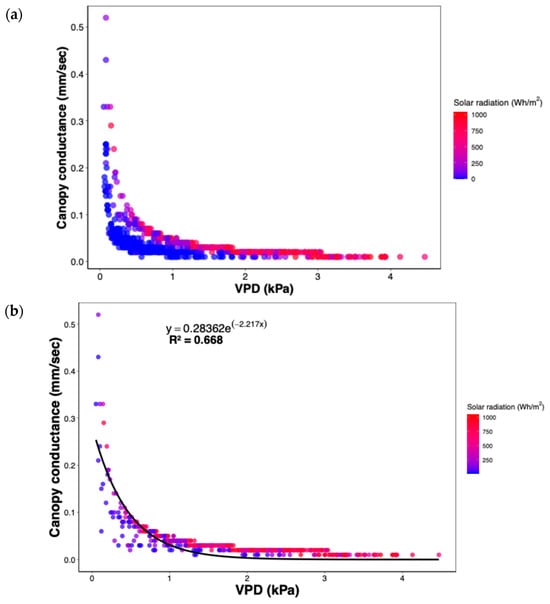
Figure 13.
Covariation of canopy conductance (gc) with VPD for the entire dataset (a) and for conditions where solar radiation (Rs) > 1 Wh/m2 (b).
Model III—2024 (Below the Threshold Value of Rs)
Using the identified threshold value of Rs for 2024, the next step involves examining the covariation between gc and VPD (Figure 14). The relationship between gc and VPD follows an exponential form (Equation (6)), which suggests that the underlying relationship is intrinsically nonlinear.

Figure 14.
Relationship between canopy conductance (gc) and VPD below the threshold of solar radiation (Rs) during 2024. As previously described, data indicators are color-coded according to the intensity of Rs as indicated in the legend on the right. The grey-shaded area represents the confidence interval at α = 0.05.
Thus, similarly to the previous cases, the following exponential model was tested:
However, this model resulted in a non-random and heavily skewed distribution of the residuals, indicating a poor model fit (Equation (A1), Table A1, Figure A2, Appendix B). To address this issue, a logarithmic transformation was applied, which is known to convert nonlinear relationships into linear [34], as shown in Figure A3, Appendix B, resulting in the following form of log-linear equation:
The previous can thus be estimated using linear regression with the ‘lm’ function in R (fitted values are shown in Table A1, Appendix B). However, given the inherently nonlinear relationship between gc and VPD, an alternative estimation using nonlinear least squares (‘nls’) was also examined to determine which of the methods could capture the data structure more effectively. Based on the AIC and the k-fold cross-validation performance, the two approaches scored the same AIC values (Table 3), although based on the results of the k-fold cross-validation, the nonlinear approach achieved higher predictive accuracy (R2mean of 0.942 versus 0.878) and a lower RMSEmean (Table 3). Thus, the model of Equation (9) (Table 4) is considered the better model for the present case (Figure 15).

Table 3.
Model comparison based on AIC, mean R2, and mean RMSE.

Table 4.
Fitted values of Model III (below the threshold value of Rs during 2024).

Figure 15.
Variation of mean RMSE (a) and mean R2 per fold (b) of Model III.
The final model (Model III) after the logarithmic transformation is the following:
For better interpretability after back-transformation, the model takes the following form:
To further evaluate the suitability of the model, a graphical display of residuals is presented, which appeared to be randomly distributed without apparent trends or clustering (Figure 16).
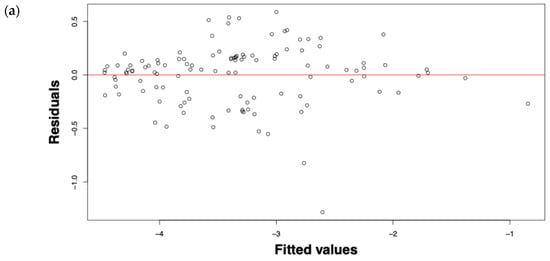
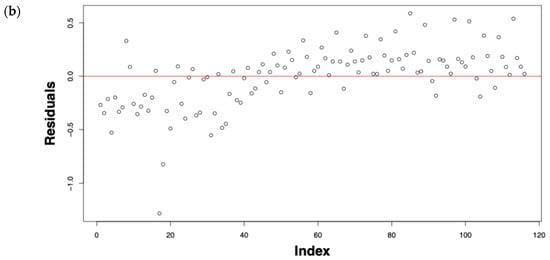
Figure 16.
Residual diagnostics of Model III. Residuals versus fitted values (a) and versus index (b).
Model IV—2024 (Above the Threshold Value of Rs)
Following the methodology applied in the previous analysis, a similar approach was followed for the dataset above the Rs threshold of 2024. The relationship between gc and VPD is shown in Figure 17, where the exponential decay trend is shown. After a systematic comparison of different models (relevant analysis is not presented), the best-performing model, as in the previous case analysis, was the log-transformed nonlinear regression model presented in Equation (8). Each parameter contributes significantly to the model (Table 5), while the residual standard error (0.05724) indicates a strong model fit.
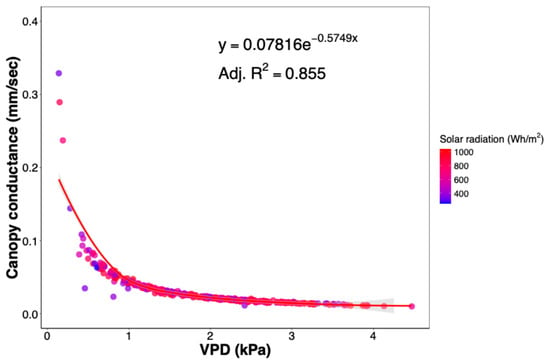
Figure 17.
Relationship between canopy conductance (gc) and VPD during 2024 (above the threshold values of solar radiation (Rs).

Table 5.
Fitted values of Model IV (above the threshold value of Rs during 2024).
With back-transformation to its original form, the model can be written as follows:
Moreover, the residuals exhibited a random distribution and an approximately typical pattern, with no discernible trends or systematic deviations, further confirming the model’s suitability (Figure 18). Additionally, the k-fold cross-validation analysis reinforced the model’s predictive accuracy, as evidenced by the high value of R2mean (0.962) and the low RMSEmean (0.00112) (Figure 19).
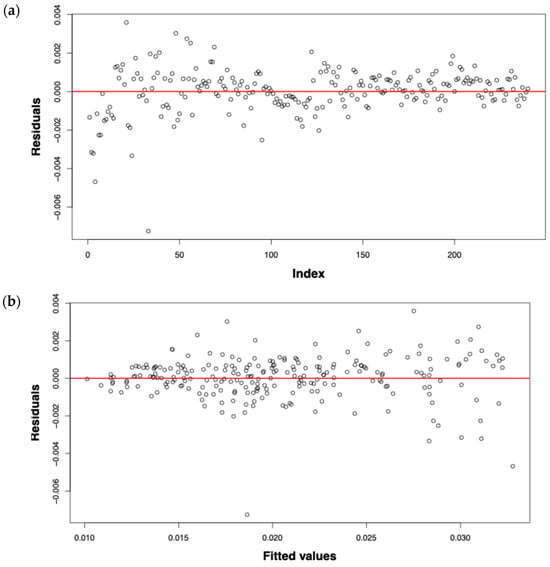
Figure 18.
Residuals diagnostics of Model IV. Residuals versus fitted values (a) and versus index (b).
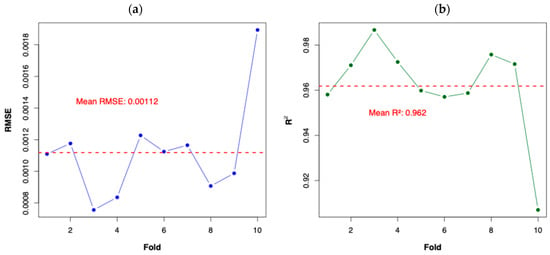
Figure 19.
Performance evaluation of Model IV using k-fold cross-validation. Variation of mean RMSE (a) and mean R2 per fold (b).
3.3. Variability in Model Parameters Between 2023 and 2024 Under Contrasting Water Conditions
3.3.1. Comparison of Models I and III
In these models, the parameter ‘a’ representing the reference gc was higher in 2023 compared to 2024 (Table 6), indicating greater conductance under low Rs and low VPD conditions in the non-irrigated vines. Such a response suggests increased stomatal opening during these periods of the day. Conditions with an Rs of approximately 270 Wh/m2 or less were observed around 08:00–09:00 am and 07:00–08:00 pm. Excluding the afternoon hours, which are not conducive to carbon assimilation, the microclimatic conditions between 08:00 and 09:00 am obviously favored photosynthesis over transpirational water losses. Thus, the higher stomatal opening observed in 2023 seems to be an effective adaptive mechanism for achieving photosynthetic production at minimum water losses. Conversely, under abundant water in the soil, as in 2024, grapevine stomatal conductance progressively increased during the day following the increase in Rs, aiming to maximize photosynthetic performance irrespective of water losses.

Table 6.
Model of gc and their performance metrics for 2023 and 2024.
The sensitivity of stomata to atmospheric drying (VPD), represented by the parameter ‘b’, exhibited minor differences between the two study years. In particular, it was higher in 2024 (Model III) compared to the Model I (2023). This subtle difference suggests that under continuous irrigation in 2024, gc exhibited a marginally weaker decline with increasing VPD. In contrast, in 2023, when the grapevines were not irrigated, the slightly more negative ‘b’ value indicates a more substantial stomatal closure as a response to rising atmospheric demand. This finding aligns with the expectation that water-limited grapevines exhibit tighter stomatal regulation to mitigate excessive water loss [44], whereas irrigated vines maintain a more moderate response to VPD fluctuations.
Following the comparison of ‘b’, the parameter ‘c’, which represents the influence of Rs on gc, exhibited a notable difference between the below-threshold models of 2023 and 2024. In 2023, ‘c’ was relatively low (4.088 × 10−5) but statistically significant (Table 1), indicating that under non-irrigated conditions, Rs had a limited yet measurable effect on stomatal conductance, mainly during the early morning. In contrast, in 2024, ‘c’ was substantially higher (0.2282), suggesting that Rs played a more dominant role in regulating gc, even under lower Rs values under conditions of sufficient soil moisture. This result implies that in well-watered grapevines, stomatal responses were more sensitive to Rs, potentially allowing for a more flexible regulation of transpiration in response to changing light availability.
3.3.2. Comparison of Models II and IV
In the ‘above-threshold’ models (Models II and IV), the parameter ‘a’ was practically similar between the study years (Table 6). This consistency was expected, as it primarily reflects the intrinsic canopy conductance of this grapevine variety, which is a relatively stable physiological characteristic.
On the other hand, parameter ‘b’, which measures the sensitivity of gc to increasing VPD, was slightly higher in 2023 (−0.6043) compared to 2024 (−0.97075). This indicates a more gradual decline in gc with increasing VPD under non-irrigated conditions. In 2023, when vines were exposed to water stress, stomata were already partially closed due to soil water limitations, reducing their responsiveness to atmospheric evaporative demand. These findings are consistent with previous research on Vitis vinifera, which has demonstrated strong stomatal regulation under drought conditions [50,51]. Additionally, grapevines are known for their inherently reduced sensitivity to VPD, which is an ecophysiological strategy to mitigate heat stress damage in the leaves [52]. In contrast, under well-watered conditions in 2024, the more negative value of this parameter indicates a steeper decline in gc with increasing VPD, suggesting a more dynamic stomatal adjustment to atmospheric conditions. This behavior reflects the inherent plasticity of this plant species, which allows it to optimize water use efficiency under varying water availability, which gives it increased resistance under any condition of water availability, thereby enhancing its resilience across diverse environmental conditions [14,47].
The parameter ‘c’, which accounts for the influence of Rs on gc, was positive in 2023 and slightly negative in 2024 (Table 6). The positive value in 2023 suggests that increasing Rs positively affected gc, indicating a more substantial reliance on solar radiation-driven photosynthesis during favorable morning conditions. Conversely, in 2024, the value of this parameter was slightly negative. This suggests that VPD, rather than Rs, primarily governed stomatal responses. The increased stomatal regulation likely aimed to prevent excessive transpiration under high Rs, as high radiation levels often coincide with elevated VPD.
3.4. Application of Nonlinear Models to Estimate Ec
To evaluate the accuracy of the nonlinear models in estimating Ec, the predicted values of Ec derived from the model gc (Equation (2)) were compared against the measured values of Ec that were based on sap flow measurements. The results of each case are shown in Figure 20.
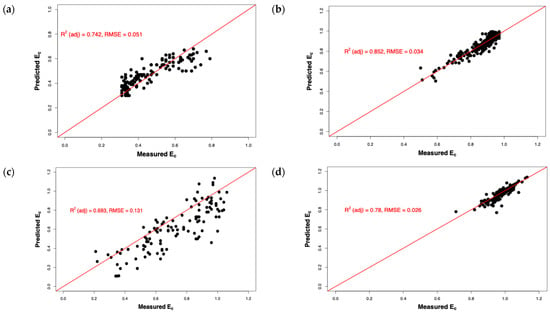
Figure 20.
Relationship between measured and predicted Ec during 2023, below (a) and above (b) the threshold value of Rs, and during 2024 below (c) and above (d) the threshold value of Rs.
In 2023, when Rs was below the threshold (Figure 20a), the model resulted in an adjusted R2 of 0.742 and a root mean square error (RMSE) of 0.051. While the model captured the general trend of transpiration, there was a noticeable scatter of data points below the 1:1 line, particularly for higher measured values of Ec.
Conversely, when Rs exceeded the threshold in 2023, the model’s performance improved significantly, achieving an adjusted R2 of 0.852 and a reduced RMSE of 0.034 (Figure 20b). In this scenario, the data points were closely aligned with the 1:1 line, indicating a better match between the predicted and measured values of Ec. This improvement suggests that, under higher Rs conditions, the model was more accurate in capturing the factors regulating transpiration, potentially due to an enhanced stomatal response to solar radiation.
In 2024, the model’s performance declined when Rs was below the threshold (Figure 20c), resulting in an adjusted R2 of 0.693 and an RMSE of 0.131. This was reflected in the wider distribution of data points below the 1:1 line, indicating a potential underestimation of Ec. This result may be attributed to the regular irrigation applied in 2024, which altered the typical stomatal response to VPD and Rs. Unlike the non-irrigated conditions in 2023, where stomatal regulation was likely limited by soil moisture availability, the well-watered vines in 2024 may have displayed a different interaction between Rs and VPD, introducing some variability into the model predictions.
However, the model demonstrated improved predictive accuracy in 2024 when Rs was above the threshold, with an adjusted R2 of 0.78 and an RMSE of 0.026 (Figure 20d). Similar to 2023, transpiration was better captured under higher Rs conditions, with data points more closely clustered along the 1:1 line.
4. Conclusions
This study examined the response of gc to environmental drivers under contrasting water availability conditions over two study years, which ultimately allowed the estimation of Ec. By developing and evaluating nonlinear models of gc, key differences emerged between the irrigated and non-irrigated conditions, particularly in the sensitivity of gc to VPD and Rs.
Model comparisons revealed that the baseline conductance parameter (parameter a) remained relatively stable across the study years, potentially reflecting an intrinsic characteristic of the studied grapevine variety. However, the sensitivity of gc to VPD, captured by parameter b, was lower (more negative) under irrigated conditions in 2024, indicating a stronger stomatal closure response to increasing atmospheric demand. The previous suggests that under sufficient soil moisture, vines exhibited a more dynamic regulation of transpiration, adjusting their water loss in response to external conditions.
The effect of Rs, as indicated by parameter c, was statistically significantly different between the two study years. In 2023, Rs positively influenced gc, while under continuous irrigation (2024), Rs exhibited a slight negative effect, potentially indicating a more complex interplay between environmental drivers and stomatal function.
Cross-validation and model evaluation further supported the predictive reliability of the developed models, particularly in conditions where Rs exceeded the threshold value where the highest model performance was observed. The comparison between measured and predicted canopy transpirational losses (Ec) indicated that model accuracy was generally higher under conditions of high solar radiation, aligning with expectations of increased stomatal activity during peak photosynthetic periods.
Overall, this study emphasizes the importance of soil water availability in modulating the physiological response of grapevines to environmental drivers. These findings provide valuable insights regarding the water management strategy of vineyards, particularly in regions where water availability is limited, like in the Mediterranean basin.
Author Contributions
Conceptualization, E.K., A.Z., and A.P.; methodology, E.K.; formal analysis, E.K.; resources, D.E.T. and E.A.P.; writing—original draft preparation, E.K.; writing—review and editing, E.K., A.Z., and A.P.; visualization, E.K. and A.Z.; supervision, A.Z. and A.P. All authors have read and agreed to the published version of the manuscript.
Funding
This research was implemented in the framework of the “M16SYN2-00333, STAFILOS” project and was funded by the Sub-Measure 16.1-16.2-Establishment and operation of Operational Groups (O.G.) of the European Innovation Partnership (EIP) for agricultural productivity and sustainability/Action 2-Implementation of the Operational Plan (project) of the EIP Operational Groups for the productivity and sustainability of agriculture.
Data Availability Statement
Data are contained within this article.
Conflicts of Interest
The authors declare no conflicts of interest.
Appendix A
The effect of Rs on the transpiration losses of the vine is significant. Therefore, it was necessary to study the covariation of solar radiation intensity with the target parameter, Ec. Before this analysis, measurements related to the nighttime were removed because they fell outside the scope of the work. Thus, Figure A1 represents the relationship between Ec and Rs with corresponding color gradients representing VPD during 2023, and Figure A2 is the corresponding analysis for 2024. The piecewise regression analysis applied to the data allowed the identification of 271.03 Wh/m2 as the breaking point for 2023 and 225.09 Wh/m2 for 2024. This analysis can describe relationships that exhibit different trends (of linear fashion) across distinct ranges of an independent variable and is particularly useful in ecophysiological studies where threshold effects typically govern the behavior of ecophysiological parameters [53]. Based on these threshold values, two different conditions can be distinguished per case: (i) below the breaking point (bp), where Ec increases rapidly with Rs following a steeper slope, indicating the significant influence of Rs to the stomatal opening, and (ii) above the breaking point where the increase in transpirational fluxes slows, suggesting a potential regulatory mechanism (stomatal control) to limit further water loss.

Figure A1.
Determination of the solar radiation (Rs) threshold using piecewise linear regression between Rs and canopy transpiration (Ec) during 2023 (a) and 2024 (b). In the plot, the breaking point (‘bp’) is indicated by the blue dashed line.
Appendix B
Initial results of using an exponential model for the case ‘2024 below threshold value of Rs’.
The model was the following:

Table A1.
Fitted values of the model below the threshold value of Rs during 2024.
Table A1.
Fitted values of the model below the threshold value of Rs during 2024.
| Parameter | Estimate | Standard Error | t-Value | p-Value |
|---|---|---|---|---|
| a | 0.05919 | 0.001170 | 50.61 | <2 × 10−16 *** |
| b | −0.6043 | 0.01254 | −48.21 | <2 × 10−16 *** |
| c | 5.041 × 10−6 | 2.427 × 10−7 | 20.77 | <2 × 10−16 *** |
Asterisks (***) indicate the statistical significance of the parameters in α = 0.001.
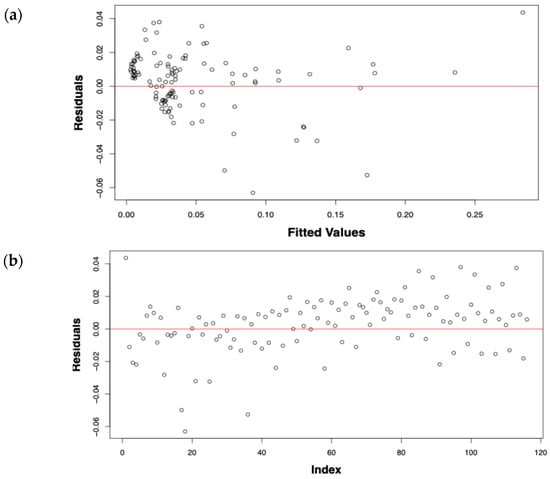
Figure A2.
Diagnostics of the exponential model. Residuals versus fitted values (a) and versus index (b).
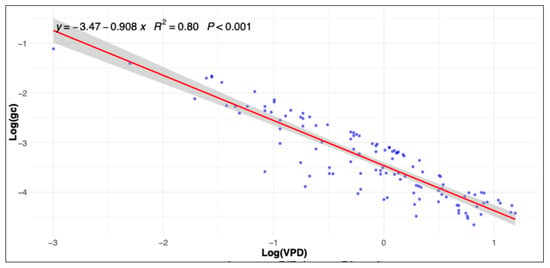
Figure A3.
Linear correlation between log(gc) and log(VPD) in the case of ‘2024 below Rs threshold’.

Figure A4.
K-fold cross validation of the linear model in the case of ‘2024 below Rs threshold’. (a) Variation of mean RMSE and (b) mean R2 per fold.
References
- Damour, G.; Simonneau, T.; Cochard, H.; Urban, L. An Overview of Models of Stomatal Conductance at the Leaf Level. Plant Cell Environ. 2010, 33, 1419–1438. [Google Scholar] [CrossRef]
- Buckley, T.N.; Mott, K.A. Modelling Stomatal Conductance in Response to Environmental Factors. Plant Cell Environ. 2013, 36, 1691–1699. [Google Scholar] [CrossRef]
- Igarashi, Y.; Kumagai, T.; Yoshifuji, N.; Sato, T.; Tanaka, N.; Tanaka, K.; Suzuki, M.; Tantasirin, C. Environmental Control of Canopy Stomatal Conductance in a Tropical Deciduous Forest in Northern Thailand. Agric. For. Meteorol. 2015, 202, 1–10. [Google Scholar] [CrossRef]
- Xu, J.; Wu, B.; Ryu, D.; Yan, N.; Zhu, W.; Ma, Z. A Canopy Conductance Model with Temporal Physiological and Environmental Factors. Sci. Total Environ. 2021, 791, 148283. [Google Scholar] [CrossRef]
- Bai, Y.; Zhu, G.; Su, Y.; Zhang, K.; Han, T.; Ma, J.; Wang, W.; Ma, T.; Feng, L. Hysteresis Loops between Canopy Conductance of Grapevines and Meteorological Variables in an Oasis Ecosystem. Agric. For. Meteorol. 2015, 214–215, 319–327. [Google Scholar] [CrossRef]
- Wan, L.; Zhang, Q.; Cheng, L.; Liu, Y.; Qin, S.; Xu, J.; Wang, Y. What Determines the Time Lags of Sap Flux with Solar Radiation and Vapor Pressure Deficit? Agric. For. Meteorol. 2023, 333, 109414. [Google Scholar] [CrossRef]
- Zeppel, M.J.B.; Murray, B.R.; Barton, C.; Eamus, D. Seasonal Responses of Xylem Sap Velocity to VPD and Solar Radiation during Drought in a Stand of Native Trees in Temperate Australia. Funct. Plant Biol. 2004, 31, 461. [Google Scholar] [CrossRef]
- Oogathoo, S.; Houle, D.; Duchesne, L.; Kneeshaw, D. Vapour Pressure Deficit and Solar Radiation Are the Major Drivers of Transpiration of Balsam Fir and Black Spruce Tree Species in Humid Boreal Regions, Even during a Short-Term Drought. Agric. For. Meteorol. 2020, 291, 108063. [Google Scholar] [CrossRef]
- Egipto, R.J.L.; Aquino, A.; Andújar, J.M. Predicting the Canopy Conductance to Water Vapor of Grapevines Using a Biophysical Model in a Hot and Arid Climate. Front. Plant Sci. 2024, 15, 1334215. [Google Scholar] [CrossRef]
- Lu, P.; Yunusa, I.A.M.; Walker, R.R.; Müller, W.J. Regulation of Canopy Conductance and Transpiration and Their Modelling in Irrigated Grapevines. Funct. Plant Biol. 2003, 30, 689. [Google Scholar] [CrossRef]
- Haijun, L.; Cohen, S.; Lemcoff, J.H.; Israeli, Y.; Tanny, J. Sap Flow, Canopy Conductance and Microclimate in a Banana Screenhouse. Agric. For. Meteorol. 2015, 201, 165–175. [Google Scholar] [CrossRef]
- Tang, J.; Bolstad, P.V.; Ewers, B.E.; Desai, A.R.; Davis, K.J.; Carey, E.V. Sap Flux–Upscaled Canopy Transpiration, Stomatal Conductance, and Water Use Efficiency in an Old Growth Forest in the Great Lakes Region of the United States. J. Geophys. Res. Biogeosci. 2006, 111, G02009. [Google Scholar] [CrossRef]
- Granier, A.; Loustau, D.; Bréda, N. A Generic Model of Forest Canopy Conductance Dependent on Climate, Soil Water Availability and Leaf Area Index. Ann. For. Sci. 2000, 57, 755–765. [Google Scholar] [CrossRef]
- Beis, A.; Patakas, A. Differences in Stomatal Responses and Root to Shoot Signalling between Two Grapevine Varieties Subjected to Drought. Funct. Plant Biol. 2010, 37, 139. [Google Scholar] [CrossRef]
- Gambetta, G.A.; Herrera, J.C.; Dayer, S.; Feng, Q.; Hochberg, U.; Castellarin, S.D. The Physiology of Drought Stress in Grapevine: Towards an Integrative Definition of Drought Tolerance. J. Exp. Bot. 2020, 71, 4658–4676. [Google Scholar] [CrossRef]
- Linhart, L.; Moretti, B.; Herrera, J.C.; Forneck, A. Maximum Stomatal Conductance Rather than Stomatal Sensitivity to Drought Differentiates the PIWI Grapevine Cultivar Souvignier Gris from Muscaris and Donauriesling. OENO One 2023, 57, 129–138. [Google Scholar] [CrossRef]
- Chaves, M.M.; Zarrouk, O.; Francisco, R.; Costa, J.M.; Santos, T.; Regalado, A.P.; Rodrigues, M.L.; Lopes, C.M. Grapevine under Deficit Irrigation: Hints from Physiological and Molecular Data. Ann. Bot. 2010, 105, 661–676. [Google Scholar] [CrossRef]
- Hochberg, U.; Bonel, A.G.; David-Schwartz, R.; Degu, A.; Fait, A.; Cochard, H.; Peterlunger, E.; Herrera, J.C. Grapevine Acclimation to Water Deficit: The Adjustment of Stomatal and Hydraulic Conductance Differs from Petiole Embolism Vulnerability. Planta 2017, 245, 1091–1104. [Google Scholar] [CrossRef]
- Herrera, J.C.; Calderan, A.; Gambetta, G.A.; Peterlunger, E.; Forneck, A.; Sivilotti, P.; Cochard, H.; Hochberg, U. Stomatal Responses in Grapevine Become Increasingly More Tolerant to Low Water Potentials throughout the Growing Season. Plant J. 2022, 109, 804–815. [Google Scholar] [CrossRef]
- González-Armas, R.; Vilà-Guerau de Arellano, J.; Mangan, M.R.; Hartogensis, O.; de Boer, H. Impact of Canopy Environmental Variables on the Diurnal Dynamics of Water and Carbon Dioxide Exchange at Leaf and Canopy Level. Biogeosciences 2024, 21, 2425–2445. [Google Scholar] [CrossRef]
- Alam, M.S.; Lamb, D.W.; Warwick, N.W.M. A Canopy Transpiration Model Based on Scaling Up Stomatal Conductance and Radiation Interception as Affected by Leaf Area Index. Water 2021, 13, 252. [Google Scholar] [CrossRef]
- Aghelpour, P.; Varshavian, V.; Khodamorad Pour, M.; Hamedi, Z. Comparing Three Types of Data-Driven Models for Monthly Evapotranspiration Prediction under Heterogeneous Climatic Conditions. Sci. Rep. 2022, 12, 17363. [Google Scholar] [CrossRef]
- Akaike, H. Akaike’s Information Criterion. In International Encyclopedia of Statistical Science; Springer: Berlin/Heidelberg, Germany, 2011; p. 25. [Google Scholar]
- Akaike, H. Information Theory and an Extension of the Maximum Likelihood Principle. In Selected Papers of Hirotugu Akaike; Springer: New York, NY, USA, 1998; pp. 199–213. [Google Scholar]
- James, G.; Witten, D.; Hastie, T.; Tibshirani, R. An Introduction to Statistical Learning; Springer: New York, NY, USA, 2021; ISBN 978-1-0716-1417-4. [Google Scholar]
- Patakas, A.; Noitsakis, B. An Indirect Method of Estimating Leaf Area Index in Cordon Trained Spur Pruned Grapevines. Sci. Hortic. 1999, 80, 299–305. [Google Scholar] [CrossRef]
- Allen, R.G.; Pereira, L.S.; Raes, D.; Smith, M. FAO Irrigation and Drainage Paper No. 56—Crop Evapotranspiration; Food and Agriculture Organization of the United Nations: Rome, Italy, 1998. [Google Scholar]
- Patakas, A.; Triantafyllidis, V.; Kokkotos, E.; Zotos, A.; Michos, K.; Karaboiki, K.; Chatzipapadopoulos, F. Irrigation Scheduling Using Continuously Monitored Data of Soil Volumetric Water Content. Acta Hortic. 2022, 1335, 613–618. [Google Scholar] [CrossRef]
- Burgess, S.S.O.; Adams, M.A.; Turner, N.C.; Beverly, C.R.; Ong, C.K.; Khan, A.A.H.; Bleby, T.M. An Improved Heat Pulse Method to Measure Low and Reverse Rates of Sap Flow in Woody Plants. Tree Physiol. 2001, 21, 589–598. [Google Scholar] [CrossRef]
- Lorenz, D.H.; Eichhorn, K.W.; Bleiholder, H.; Klose, R.; Meier, U.; Weber, E. Growth Stages of the Grapevine: Phenological Growth Stages of the Grapevine (Vitis Vinifera L. Ssp. Vinifera)—Codes and Descriptions According to the Extended BBCH Scale. Aust. J. Grape Wine Res. 1995, 1, 100–103. [Google Scholar] [CrossRef]
- Monteith, J.L.; Unsworth, M.H. Principles of Environmental Physics, 2nd ed.; Butterworth-Heinemann: Oxford, UK, 1990; ISBN 071312931X. [Google Scholar]
- Yager, R.M. Detecting Influential Observations in Nonlinear Regression Modeling of Groundwater Flow. Water Resour. Res. 1998, 34, 1623–1633. [Google Scholar] [CrossRef]
- Riazoshams, A.H.; Habshah, B.M., Jr.; Adam, A.M.B. On the Outlier Detection in Nonlinear Regression. Int. J. Math. Comput. Phys. Electr. Comput. Eng. 2009, 12, 1105–1111. [Google Scholar]
- Lepš, J.; Šmilauer, P. Biostatistics with R; Cambridge University Press: Cambridge, UK, 2020; ISBN 9781108616041. [Google Scholar]
- Spiess, A.-N.; Neumeyer, N. An Evaluation of R2 as an Inadequate Measure for Nonlinear Models in Pharmacological and Biochemical Research: A Monte Carlo Approach. BMC Pharmacol. 2010, 10, 6. [Google Scholar] [CrossRef]
- Muggeo, V.M.R. Estimating Regression Models with Unknown Break-Points. Stat. Med. 2003, 22, 3055–3071. [Google Scholar] [CrossRef]
- Fasola, S.; Muggeo, V.M.R.; Küchenhoff, H. A Heuristic, Iterative Algorithm for Change-Point Detection in Abrupt Change Models. Comput. Stat. 2018, 33, 997–1015. [Google Scholar] [CrossRef]
- Posit team. RStudio: Integrated Development Environment for R; Posit Software, PBC: Boston, MA, USA, 2023; Available online: http://www.posit.co/ (accessed on 8 June 2025).
- Wickham, H. Ggplot2-Elegant Graphics for Data Analysis, 2nd ed.; Gentleman, R., Hornik, K., Parmigiani, G., Eds.; Springer International Publishing: Houston, TX, USA, 2016; ISBN 978-3-319-24275-0. [Google Scholar]
- Kuhn, M.; Johnson, K. Applied Predictive Modeling; Springer: New York, NY, USA, 2013; ISBN 978-1-4614-6848-6. [Google Scholar]
- Stoy, P.C.; Trowbridge, A.M.; Bauerle, W.L. Controls on Seasonal Patterns of Maximum Ecosystem Carbon Uptake and Canopy-Scale Photosynthetic Light Response: Contributions from Both Temperature and Photoperiod. Photosynth. Res. 2014, 119, 49–64. [Google Scholar] [CrossRef]
- Wan, Y.; Peng, L.; Anwaier, A.; Shi, H.; Li, D.; Ma, Y.; Shi, Q. Effects of Meteorological Factors and Groundwater Depths on Sap Flow Density of Populus Euphratica in a Desert Oasis, Taklamakan Desert, China. Front. Plant Sci. 2024, 15, 1330426. [Google Scholar] [CrossRef]
- Kokkotos, E.; Zotos, A.; Triantafyllidis, V.; Patakas, A. Impact of Fruit Load on the Replenishment Dynamics of Internal Water Reserves in Olive Trees. Agronomy 2024, 14, 1026. [Google Scholar] [CrossRef]
- Zhang, Y.; Meinzer, F.C.; Qi, J.; Goldstein, G.; Cao, K. Midday Stomatal Conductance Is More Related to Stem Rather than Leaf Water Status in Subtropical Deciduous and Evergreen Broadleaf Trees. Plant Cell Environ. 2013, 36, 149–158. [Google Scholar] [CrossRef]
- Granier, A.; Biron, P.; Lemoine, D. Water Balance, Transpiration and Canopy Conductance in Two Beech Stands. Agric. For. Meteorol. 2000, 100, 291–308. [Google Scholar] [CrossRef]
- Zhu, G.; Lu, L.; Su, Y.; Wang, X.; Cui, X.; Ma, J.; He, J.; Zhang, K.; Li, C. Energy Flux Partitioning and Evapotranspiration in a Sub-alpine Spruce Forest Ecosystem. Hydrol. Process. 2014, 28, 5093–5104. [Google Scholar] [CrossRef]
- Beis, A.; Patakas, A. Relative Contribution of Photoprotection and Anti-Oxidative Mechanisms to Differential Drought Adaptation Ability in Grapevines. Environ. Exp. Bot. 2012, 78, 173–183. [Google Scholar] [CrossRef]
- Grossiord, C.; Buckley, T.N.; Cernusak, L.A.; Novick, K.A.; Poulter, B.; Siegwolf, R.T.W.; Sperry, J.S.; McDowell, N.G. Plant Responses to Rising Vapor Pressure Deficit. New Phytol. 2020, 226, 1550–1566. [Google Scholar] [CrossRef]
- Whitley, R.; Zeppel, M.; Armstrong, N.; Macinnis-Ng, C.; Yunusa, I.; Eamus, D. A Modified Jarvis-Stewart Model for Predicting Stand-Scale Transpiration of an Australian Native Forest. Plant Soil 2008, 305, 35–47. [Google Scholar] [CrossRef]
- Chaves, M.M.; Costa, J.M.; Zarrouk, O.; Pinheiro, C.; Lopes, C.M.; Pereira, J.S. Controlling Stomatal Aperture in Semi-Arid Regions—The Dilemma of Saving Water or Being Cool? Plant Sci. 2016, 251, 54–64. [Google Scholar] [CrossRef] [PubMed]
- Soar, C.J.; Collins, M.J.; Sadras, V.O. Irrigated Shiraz Vines (Vitis Vinifera) Upregulate Gas Exchange and Maintain Berry Growth in Response to Short Spells of High Maximum Temperature in the Field. Funct. Plant Biol. 2009, 36, 801. [Google Scholar] [CrossRef] [PubMed]
- Faralli, M.; Bontempo, L.; Bianchedi, P.L.; Moser, C.; Bertamini, M.; Lawson, T.; Camin, F.; Stefanini, M.; Varotto, C. Natural Variation in Stomatal Dynamics Drives Divergence in Heat Stress Tolerance and Contributes to Seasonal Intrinsic Water-Use Efficiency in Vitis Vinifera (Subsp. Sativa and Sylvestris). J. Exp. Bot. 2022, 73, 3238–3250. [Google Scholar] [CrossRef]
- Kokkotos, E.; Zotos, A.; Tsirogiannis, G.; Patakas, A. Prediction of Olive Tree Water Requirements under Limited Soil Water Availability, Based on Sap Flow Estimations. Agronomy 2021, 11, 1318. [Google Scholar] [CrossRef]
Disclaimer/Publisher’s Note: The statements, opinions and data contained in all publications are solely those of the individual author(s) and contributor(s) and not of MDPI and/or the editor(s). MDPI and/or the editor(s) disclaim responsibility for any injury to people or property resulting from any ideas, methods, instructions or products referred to in the content. |
© 2025 by the authors. Licensee MDPI, Basel, Switzerland. This article is an open access article distributed under the terms and conditions of the Creative Commons Attribution (CC BY) license (https://creativecommons.org/licenses/by/4.0/).